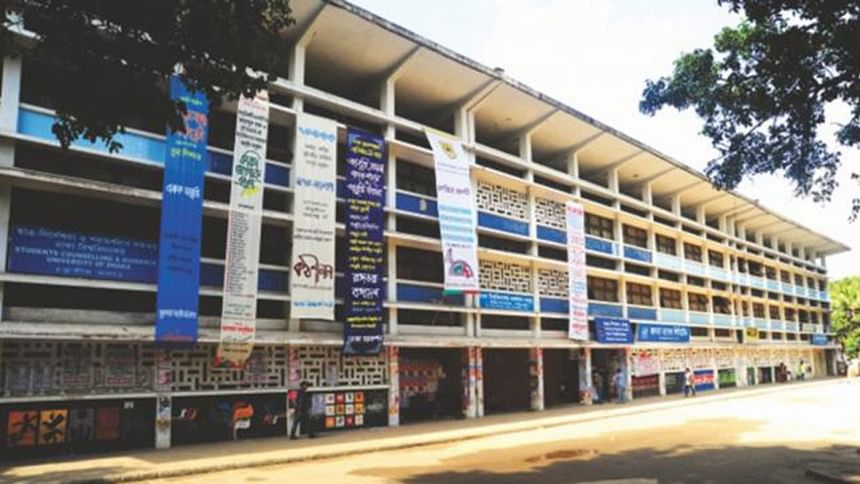A looming tragedy in the University of Dhaka’s centennial celebration

Is this the right way to celebrate the centennial of the University of Dhaka in 2021? Like many of my colleagues in Bangladesh and around the world, I was horrified to learn that the university administration has made plans to demolish a 20th century architectural icon inside the university campus to expand and upgrade its insufficient facilities. Yes, change is inevitable. And so is growth. But how does a society treat its cultural heritage as it grows? This is a perennially contested question that warrants thoughtful judgement in a specific time and place. However, it is truism that a conscientious society treats its cultural patrimony with utmost care.
The iconic Teacher-Student Centre, popularly known as TSC, the universally admired centre of the country's student politics and cultural life, may soon face the wrecking ball. This will be an irredeemable national tragedy.
Let us consider the history of this beloved building complex. The Greek architect, planner and theoretician Constantinos Apostolos Doxiadis (1913-1975) designed TSC during the early 1960s. This was a turbulent time, marked by conflicting currents of political tension and architectural optimism in what was then East Pakistan. On the one hand, the two wings of postcolonial Pakistan were at loggerheads because of the political domination of East Pakistan by the military junta based in West Pakistan. On the other hand, many architectural opportunities arose in East Pakistan between 1958 and 1968, the so-called Decade of Development that benefitted from the United States' technical assistance to Pakistan.
The United States allied with Pakistan as part of its Cold-War-era foreign policy to create a geostrategic buffer against the socialist milieu of the Soviet Union-India axis in South Asia. Under the purview of a technical assistance programme, the United States Agency for International Development and the Ford Foundation provided support for building educational and civic institutions in East Pakistan. Since there was a dearth of experienced architects in East Pakistan, the government sought the services of American and European architects for a host of buildings that were constructed during the 1960s. Doxiadis was among them.
He designed multiple institutional complexes, sponsored by the Ford Foundation. Among them were the Bangladesh Academy for Rural Development in Comilla; College of Home Economics in Dhaka, and the Institute of Education and Research, University of Dhaka. However, it was the TSC that arguably captured the imagination of the people and, given its central location, became an emblem of Dhaka's architectural modernity. Located at the historic heart of the University of Dhaka, TSC exemplifies a modernist architectural sensitivity toward spatial needs for tropical climatic conditions. It blends local parameters of space-making—particularly the indoor-outdoor continuum and generation of space around courtyards—with the International-Style's visual expression of building forms.
To gain a deeper understanding of the TSC, it helps to explore the architect's personal development, as well as his design strategy prior to this project. Doxiadis was born in 1913 in Bulgaria to Greek parents. Early on in his childhood, he was influenced by his father, who was the Greek Minister of Refugees, Social Welfare, and Public Health. Such exposure allowed him to contemplate the issues of refugee housing and how residential settlements could address global problems. In 1935, Doxiadis graduated from the Athens Technical University as an Architect-Engineer, and, a year later, he earned his doctoral degree at the Charlottenburg University, in Berlin. Subsequently, he served as Chief Town Planning Officer for Greater Athens and, during World War II, as Head of the Department of Regional and Town Planning at the Ministry of Public Works. After the war, he became the Director-General of the Ministry of Housing and Reconstruction. In 1951, he founded Doxiadis Associates, a private consulting firm of engineers, architects, and planners. Rapid growth as an international practice led to offices on five continents and projects in 40 countries.
Doxiadis created the Athens Center of Ekistics in 1963, although he had introduced the concept of "ekistics" back in the 1930s. As he later explained in his book Ekistics: An Introduction to the Science of Human Settlements (1968), the term represented an objective, comprehensive, and integrative approach to all principles and theories of human settlements. Criticising the top-down planning model of the first half of the 20th century, Doxiadis employed the notion of ekistics to promote a multidisciplinary, inclusive, and bottom-up approach to architecture and city planning. He hoped that such a method would create a synergy among the organic context of the locale, data-driven theorisation of planning, and universal values of harmonious living. Lest we forget, Doxiadis' prolific years of the 1960s coincided with the publication of a number of seminal books and articles that, in their disparate ways, criticised the ideological bases of modern industrial societies. Among the works he had studied were Rabindranath Tagore's Towards Universal Man (1961), Rachel Carson's Silent Spring (1962), Ian McHarg's Man and His Environment (1963), and Edward T Hall's The Hidden Dimensions of Man (1966).
It is evident that Doxiadis tried out his theories of ekistics at the TSC, among other projects in Bangladesh. Construction of the TSC complex began in March 1962, after the University of Dhaka authorities gave their approval of Doxiadis Associates' final design. The 3.7 acre site is located at the intersection of Bakshi Bazar Road and Mymensingh Road, with the Suhrawardy Uddyan (park) on the east. Access to the site is from the north, where three streets meet to form a major urban node and the geographic centre of the sprawling campus of the University of Dhaka. It is a historic gathering place for students and the public during such national celebrations as Victory Day, Independence Day, Language Movement Day and Pohela Baishakh (the first day of the Bengali year). The horizontal building block to the north acts as a transition from the urban hustle and bustle to the verdant interior of the complex.
Doxiadis conceived TSC as an architectural ensemble, comprising six elements: The Student Union Building, which accommodates the student union headquarters, offices for students and teachers, conference rooms, a library, lounges, bookshops, and a general store; the auditorium, which serves as a multipurpose hall and features a seating capacity of 800; the cafeteria; the guest house; the swimming pool; and the water tower (unbuilt).
The buildings are aligned with the east-west axis, to take advantage of the prevailing breeze from the south or north. The three-story Student Union Building is rectangular in plan, 158 feet by 37 feet, and composed of a reinforced concrete frame and non-loadbearing brick walls. It is a trendsetting building as the structure employs a double roof to minimise heat gain, by allowing the cool breeze to pass through the two layers of the roof. Providing a protective canopy for the building shell, the upper roof has a wing-like formation, with rainwater drainage in between. The facade of the building is a Mondrian-esque composition of vertical columns and horizontal lintels.
The auditorium, also rectangular in plan, is 170 feet by 85 feet and is covered by a reinforced concrete parabolic vault, a pioneering construction technique in the country. The auditorium has a level floor, with removable seating, and a spacious stage with dressing rooms. The airy cafeteria features a high ceiling and overlooks the sprawling courtyard to the north. It consists of two segments placed on either side of a linear green mall. The west wing of the cafeteria contains a large game room, plus dressing rooms, showers, and toilets that serve the swimming pool. The east wing houses the main eating area and a kitchen, with the customary auxiliary spaces. The hypostyle hall of the cafeteria has a reinforced concrete frame and provides a continuous band of clerestory around its perimeter. The guest house, east of the cafeteria, comprises six rooms, each with an attached bathroom and balcony.
Covered walkways, supported on steel columns, weave together the major buildings and green spaces. Functioning more like a continuous loop of linear pavilions, rather than corridors, the walkways are the social spine of the entire complex. The Teacher-Student Centre is one of the first buildings in Bangladesh to employ a pavilion theme in non-residential architecture. Extensive use of brick jalis (latticework) in the buildings ensures visual privacy while providing natural ventilation. Considered a sensible response to the needs of a tropical climate, Doxiadis assembled the buildings and courtyards in a lush tapestry of organic fluidity and spatial interconnectivity. The whole complex feels like an organic miniature city.
Over the years, TSC has become part of a national narrative. Many of the pivotal student movements took shape around this historic urban node. Furthermore, the centre is also celebrated as a verdant and breezy urban space, a rare liberating experience in this overcrowded city.
Plato once said: "Any city however small, is in fact divided into two, one the city of the poor, the other of the rich. These are at war with one another." Dhaka's war is between mindless growth and mindful growth. Which side will the University of Dhaka take?
Dhaka will be a lesser city without the TSC. Cultural heritage is essential for a city to tell its stories. Without stories, a city can only reproduce the banality of its growth for growth's sake. The University of Dhaka should focus on reversing the decline of its academic standards instead of engaging in a self-defeating agenda of mindless expansion.
Adnan Z Morshed is an architect, architectural historian, professor, and columnist. He serves as Executive Director of the Centre for Inclusive Architecture and Urbanism at BRAC University.
Email: [email protected]

 For all latest news, follow The Daily Star's Google News channel.
For all latest news, follow The Daily Star's Google News channel. 



Comments